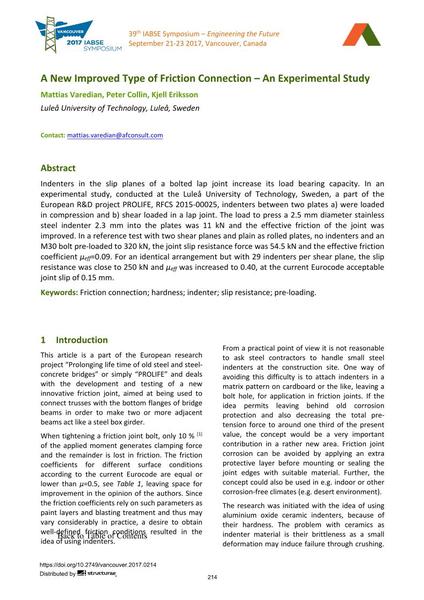A New Improved Type of Friction Connection – An Experimental Study

|
|
|||||||||||
Détails bibliographiques
| Auteur(s): |
Mattias Varedian
(Luleå University of Technology, Luleå, Sweden)
Peter Collin (Luleå University of Technology, Luleå, Sweden) Kjell Eriksson (Luleå University of Technology, Luleå, Sweden) |
||||
|---|---|---|---|---|---|
| Médium: | papier de conférence | ||||
| Langue(s): | anglais | ||||
| Conférence: | IABSE Symposium: Engineering the Future, Vancouver, Canada, 21-23 September 2017 | ||||
| Publié dans: | IABSE Symposium Vancouver 2017 | ||||
|
|||||
| Page(s): | 214-221 | ||||
| Nombre total de pages (du PDF): | 8 | ||||
| Année: | 2017 | ||||
| DOI: | 10.2749/vancouver.2017.0214 | ||||
| Abstrait: |
Indenters in the slip planes of a bolted lap joint increase its load bearing capacity. In an experimental study, conducted at the Luleå University of Technology, Sweden, a part of the European R&D project PROLIFE, RFCS 2015-00025, indenters between two plates a) were loaded in compression and b) shear loaded in a lap joint. The load to press a 2.5 mm diameter stainless steel indenter 2.3 mm into the plates was 11 kN and the effective friction of the joint was improved. In a reference test with two shear planes and plain as rolled plates, no indenters and an m³0 bolt pre-loaded to 320 kN, the joint slip resistance force was 54.5 kN and the effective friction coefficientμeff=0.09. For an identical arrangement but with 29 indenters per shear plane, the slip resistance was close to 250 kN andμeff was increased to 0.40, at the current Eurocode acceptable joint slip of 0.15 mm. |
||||
